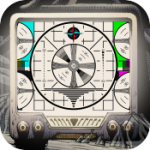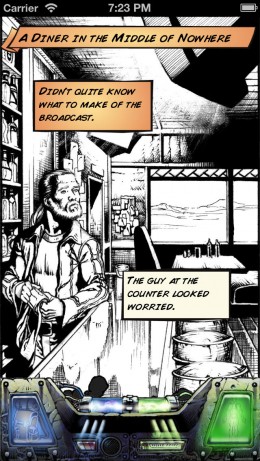 We human beings sure like to pontificate about our own species’ downfall. Whether it’s death by robots, zombies, nuclear fallout, aliens, or meteor strikes, it seems popular to speculate on how it would all go down. Perhaps by creating fictional escapes from these tragedies, we’re trying to give ourselves relief from stress about unwinnable situations. Maybe we, pampered and connected as we are in modern times, like to imagine what it would be like to go back to a world of near-lawlessness and isolation. Whatever the reason behind it, stories about the end of times are popular, and as gamers, we’re a bit rich with choices on how we indulge that curiosity.
We human beings sure like to pontificate about our own species’ downfall. Whether it’s death by robots, zombies, nuclear fallout, aliens, or meteor strikes, it seems popular to speculate on how it would all go down. Perhaps by creating fictional escapes from these tragedies, we’re trying to give ourselves relief from stress about unwinnable situations. Maybe we, pampered and connected as we are in modern times, like to imagine what it would be like to go back to a world of near-lawlessness and isolation. Whatever the reason behind it, stories about the end of times are popular, and as gamers, we’re a bit rich with choices on how we indulge that curiosity.
What set me off on that little bout of naval-gazing was This Is Not A Test: A Post-Apocalyptic Prequel ($1.99). While I’ve seen a lot of genre types applied to it, I think it’s best to describe this as a gamebook, falling somewhere between Fighting Fantasy and Choose Your Own Adventure in terms of how much game is on offer. Let me start off by saying that I love the title. See, the game’s story actually starts right when the proverbial spit hits the fan, so you’re not actually in the post-apocalypse yet. It’s a clever bit that bodes well for the writing, which for a gamebook is probably one of the more critical elements.
 The most immediate way This Is Not A Test distinguishes itself from other gamebooks is with its visual style. Rather than mimicking a book, this game instead looks to comic books for its inspiration. Specifically, the great old sci-fi/horror comics of the 1950s are wonderfully homaged right from the gorgeous title screen. The story is told panel by panel, with great illustrations and text laid out in word bubbles and dialogue boxes. Of course, this means the game is a bit lighter on text than other gamebooks, but the game works around the limitations of its format by allowing you to click on certain dialogue bubbles to read some extended text. This format choice lends the game a lot of unique flavor from the get-go. I only wish the pictures had a bit more color in them, perhaps done in that old newsprint CMYK style.
The most immediate way This Is Not A Test distinguishes itself from other gamebooks is with its visual style. Rather than mimicking a book, this game instead looks to comic books for its inspiration. Specifically, the great old sci-fi/horror comics of the 1950s are wonderfully homaged right from the gorgeous title screen. The story is told panel by panel, with great illustrations and text laid out in word bubbles and dialogue boxes. Of course, this means the game is a bit lighter on text than other gamebooks, but the game works around the limitations of its format by allowing you to click on certain dialogue bubbles to read some extended text. This format choice lends the game a lot of unique flavor from the get-go. I only wish the pictures had a bit more color in them, perhaps done in that old newsprint CMYK style.
Each game begins the same way: you must choose three skills from six possible options. These skills include driving, marksmanship, brawling, cunning, tech, and survival. The skills you choose will determine which options are made available to you throughout the story, as well as the success rate of certain actions. Every choice is viable, and every build can win, but the ways you’ll go about it are wildly different depending on what skills you possess. This gives the game a bit of replayability, which is honestly pretty rare in this genre.
However you choose, you’ll start off in the same place. An emergency warning comes in over your truck’s radio, causing you to stop where you are, just outside a store. Your choices from here will be laid out to you at the bottom of each page, so all you’re going to be doing is picking up items and selecting options. Interestingly, choosing the same options won’t always have the same result, as apparently the game is doing a bit of dice-rolling behind the scenes. Initially, I was a bit worried that the game was going to be light on variety due to the lack of any obvious stats or random mechanisms, so discovering this was very welcome, even if it can be a bit frustrating to fail something you passed before without any obvious reason as to why.
 The writing in This Is Not A Test stands shoulder-to-shoulder with the art. It’s a great adventure told in rich, pulpy style, with particularly outstanding descriptions for the death scenes. You’ll be reading a lot of those, by the way. This is a very hard game, and it’s quite a challenge to solve. Some deaths you’ll see coming but be powerless to stop, others will be less obvious but fatal all the same. Sometimes you won’t have the right skills to survive, sometimes you will, yet will fall victim to the heartlessness of the random number generator. No one ever said surviving the end would be fair, right? Every death serves as a learning experience, however, and the game is pretty good about cluing you in as to how you might have survived that encounter.
The writing in This Is Not A Test stands shoulder-to-shoulder with the art. It’s a great adventure told in rich, pulpy style, with particularly outstanding descriptions for the death scenes. You’ll be reading a lot of those, by the way. This is a very hard game, and it’s quite a challenge to solve. Some deaths you’ll see coming but be powerless to stop, others will be less obvious but fatal all the same. Sometimes you won’t have the right skills to survive, sometimes you will, yet will fall victim to the heartlessness of the random number generator. No one ever said surviving the end would be fair, right? Every death serves as a learning experience, however, and the game is pretty good about cluing you in as to how you might have survived that encounter.
Once you know your way through, the game isn’t very long at all, but as mentioned earlier, there are a variety of ways to get through the game, so you can always play again with a different set of skills to see how that plays out. I’d say it’s a bit shorter on its initial playthrough than most gamebooks, but the multiple paths bring it up to speed quite nicely. Apart from the brevity, which is par for the course for this genre, I only have a few real complaints. First of all, being that this is an obvious first chapter, the ending leaves a lot of questions hanging in the air. I sincerely hope we get some answers with another installment, because the conclusion is a bit unsatisfying for now.
Secondly, there are some issues with the interface. At first, I didn’t realize that I had to tap on the dialogue boxes introducing items in order to pick them up. The dialogue bubble told me I had the item, so it wasn’t clear that I actually didn’t have it in inventory unless I tapped it then and there. A brief pop-up of text on the first item explaining would do wonders, along with a few other brief explanations of mechanics. It’s only irritating until you realize how it works, but that the player has to work that out themselves is a bit of a failure on the part of the interface, I feel.
One final problem is that there doesn’t seem to be any way to save your game. At the very least, I’d like it if it bookmarked where I was when I have to close off the app. Unfortunately, if the game gets pushed out of memory, your game in progress will go with it. I can appreciate that there might be design reasons behind a lack of a bookmark feature, but a suspend save really is a must on a game like this.
In the end, this is a pretty good gamebook with a very unique feel to it. What initially comes off as something as shallow in terms of gameplay as a Choose Your Own Adventure novel instead turns out to have a surprising bit of depth and replayability. I still generally prefer the Fighting Fantasy series, but This Is Not A Test carves its own path with zest. I’d definitely recommend it to people who enjoy gamebooks or even fans of old pulp horror comics. People in our forums seem to be having a really good time with it, too.
